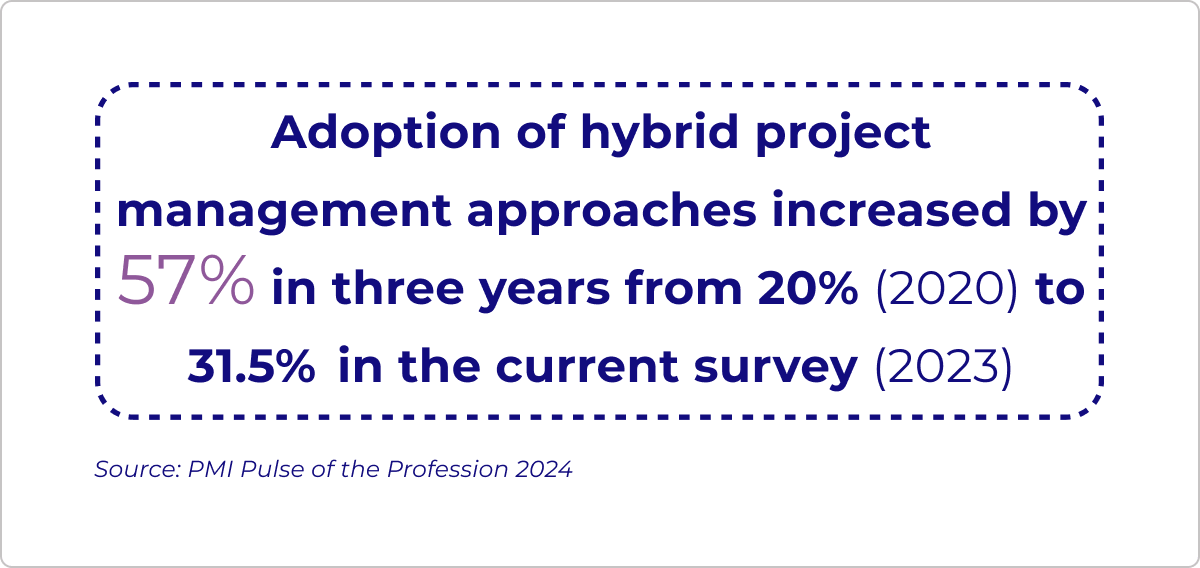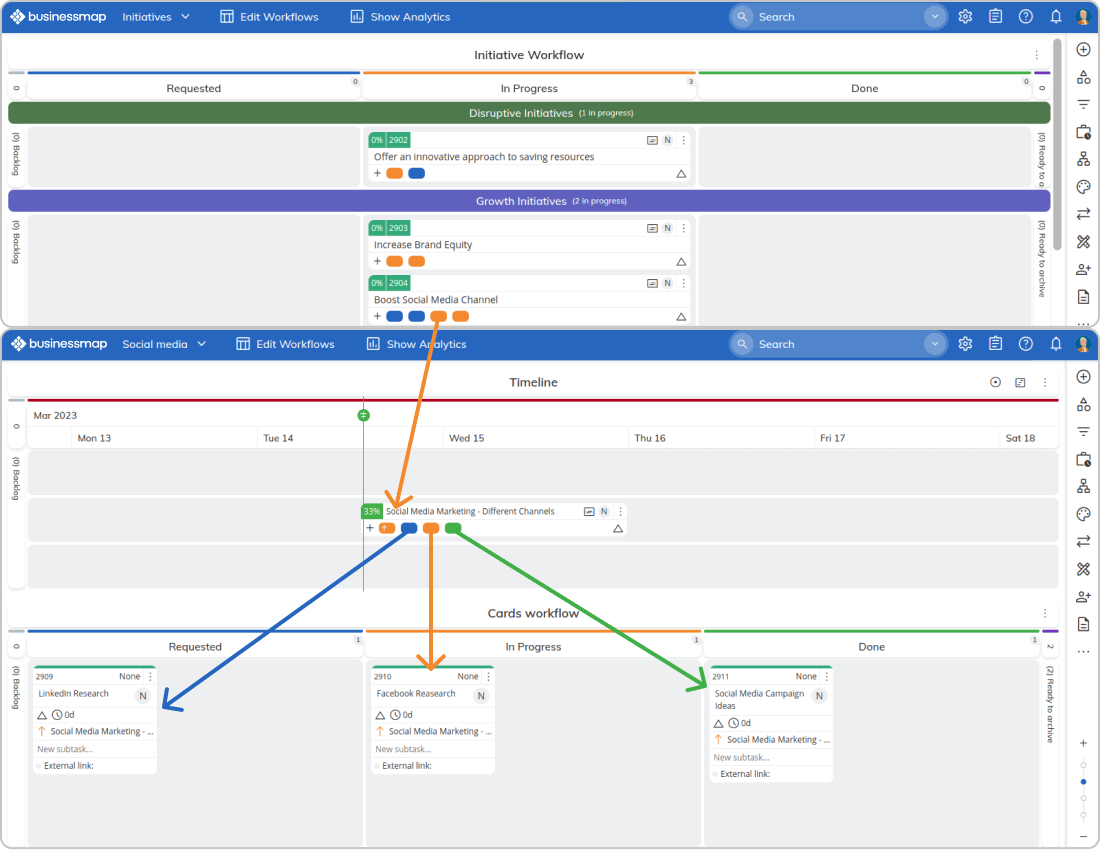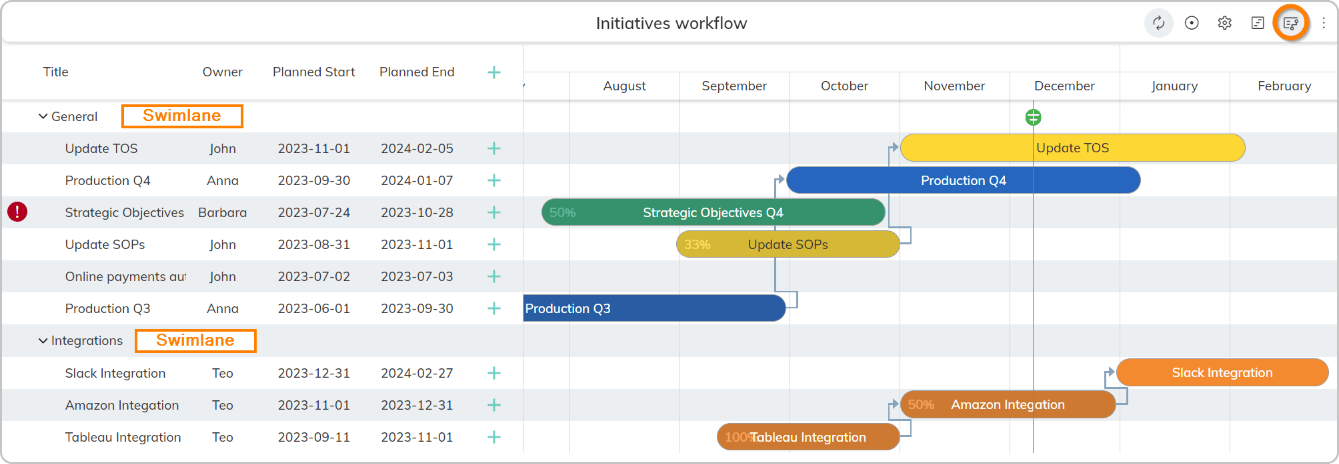Let's face it: the corporate world is rife with strategic ambitions that often miss the mark. A startling 90% of senior executives share that hitting all their strategic objectives is a mission that often falls short, all due to bad implementation. Another 59% acknowledge that their organizations regularly grapple with turning those high strategies into everyday operations.
This is where hybrid project management comes into play, serving as a pivotal bridge between strategy and operational reality. Let's explore its mechanics.
First, What Is Hybrid Project Management?
Hybrid project management integrates components from various methodologies, methods, and frameworks, enabling you to create the winning blend of practices that optimally fits your organization's specific needs. It's a savvy blend of the best of both worlds, combining the meticulousness of the Waterfall method's step-by-step planning with the dynamism and adaptability of Agile practices.

Hybrid project management is characterized by its versatility, incorporating a variety of methodologies and tools - such as transparent Kanban boards, work-in-progress limits, sprint work cycles, lead time analytics, burndown, and Gantt charts - to create a tailored approach. However, there isn't a one-size-fits-all formula for success. Different types of hybrid project management exist, each mixing elements from multiple methodologies to meet the distinct demands of a given project. Your project and organization's specific context and requirements drive the method's successful application.
Choosing the right combination of methodologies is vital to an effective hybrid approach. For instance, an organization might merge the structured, sequential phases of the Waterfall model with the adaptability and iterative nature of Agile practices. Alternatively, a team might integrate a workflow system with structured sprint cycles. The optimal mix of these strategies will invariably be distinct to each organization, reflecting its unique goals, culture, and project nuances.
The Why Behind Hybrid Project Management
By embracing the hybrid model, organizations can steer their projects with more agility and precision, ensuring that their strategic goals don't just stay on paper but come to life in the real world.
There's a growing crowd praising hybrid and adaptive management approaches, and 34% of organizations expect to lower the application of predictive methods in the coming five years. Here's a breakdown of the arguments in favor of embracing the hybrid way:
- Projects are becoming increasingly more complex.
- The business climate is as unpredictable as the weather.
- Some projects just aren't ready for a complete agile transformation.
- Internal culture isn't quite ready to embrace the agile revolution.
- Regulatory requirements demand certain features to be up and running by a specific date.
- It allows teams to move quickly while still holding onto the organizational structure that traditional waterfall methods provide.
- To foster a collaborative environment where stakeholder input is sought at every turn, ensuring the project stays aligned with real-world needs and expectations.
Benefits of the Hybrid Approach to Project Management
By combining the structured, step-by-step predictability of predictive methods with the flexibility of agile practices, hybrid project management offers a comprehensive solution that meets the diverse demands and growing complexity of projects. More of the tangible perks the hybrid approach brings to the table include:
- Clearer and Shared Vision: Hybrid project management clears the fog for everyone involved. It's about providing a lucid, overarching view of the project's trajectory, ensuring that all stakeholders are on board and working in harmony toward the shared destination.
- Seeing a Step-by-Step Realization of the Big Picture: Teams and business users witness the evolution of their vision incrementally. This real-time unfolding keeps everyone engaged as the project's progress reflects the collective aspiration.
- Proactive and Early Acceptance: There's a proactive and warm reception of new features thanks to ongoing dialogue with business users. This frequent collaboration ensures that what's being built is genuinely what's needed.
- Improved Forecasting: By defining requirements upfront, hybrid project management enables teams to foresee and shape future developments more accurately. This foresight is crucial in navigating the project's path with fewer surprises and more confidence.
- Mitigated Risk of Resistance to Change: Organizational resistance to change remains a significant barrier to Agile adoption, as highlighted by prominent agile statistics for two consecutive years. Organizations can gradually introduce elements of different methodologies by employing a hybrid project management approach. This incremental integration helps mitigate the risk of individual resistance, as team members are less likely to feel overwhelmed by sudden, comprehensive changes.
Hybrid Project Management Challenges
One of the trickiest challenges is sticking to the planned timelines when tasks take too long to complete, causing a domino effect of delays.
Teams also tend to push more complex tasks into the near future, which can lead to a backlog bottleneck.
Moreover, managing project dependencies requires close oversight, as tasks lined up in the future depend on the timely completion of their predecessors. Keeping a close eye on these relationships is crucial to prevent the project from tripping over its timeline.
Using the right project management tools is important to overcoming most of these challenges. For instance, we can clearly visualize various initiatives, projects, and individual work items by using Businessmap's ability to establish meaningful connections between them. This clarity ensures that everyone understands the work that contributes to achieving our business goal.

Furthermore, using the Gantt chart view in Businessmap (formerly Kanbanize), you can visualize dependencies between deliverables and entire projects. This way, you can easily envision your planned and actual project progress, allowing you to stay on top of risks with critical chains.

What Is a Hybrid Project Example?
The State of Agile reports a significant shift as nearly half of large companies (49%) and medium-sized companies (45%) now adopt a hybrid approach to their operations. This trend sees organizations choose the elements of different methodologies - Agile, DevOps, iterative, Waterfall, Lean, and Spiral - to craft a software development life cycle (SDLC) unique to their project demands.
Imagine a project that starts with the clear-cut Waterfall method structure, where the scope and requirements are meticulously outlined from the start. However, development and testing phases are sliced into iterative chunks, like the Scrum framework's "sprints."
During these sprints, teams plan to zero in on the most pressing tasks, ensuring that each work cycle is focused and manageable. As each sprint wraps up, a review with stakeholders is a strategic move to secure early buy-in for the work completed. This also serves to pinpoint any issues early on, allowing for swift course correction within the development cycle.
You can employ a kanban board to visualize your sprints using the Kanban practice to work visualization and map the entire Scrum process in a single information hub.

Three Essential Practices for Efficient Hybrid Project Management
Putting two approaches together can quickly bring chaos to the room. There are three critical practices to consider when managing a hybrid project.
1. Setting Clear Expectations and Project Policies
Clarity is the cornerstone of any successful hybrid project. It's imperative to establish crystal-clear project goals, deadlines, and constraints. Every team member should understand the work execution, communication policies, or scenarios that necessitate a live meeting.
2. Using Project Management Tools Consistently
The consistent use of project management tools is a lifeline for hybrid teams, mainly when they're distributed. Ensure every team member is fully onboarded and comfortable with the online tools. These tools should provide centralized workflow management, online meetings, and a central document repository.
3. Establishing a Sense of Connection
Meetings should be mere progress report sessions; progress should be communicated through suitable project dashboards. Moreover, fostering social interaction during work meetings and allowing off-topic discussions can spark creativity and strengthen team bonds. This balance helps cultivate a sense of connection and camaraderie often missing in remote or hybrid setups.
What the Future Holds for Hybrid Projects?
〉〉 Responsive Project Management: 76% and 73% of respondents of the PMI Pulse of the Profession 2024 survey anticipate an upsurge in adopting agile and hybrid methodologies within their organizations. This indicates a shift towards more flexible and responsive project management approaches that cater to modern business landscapes' dynamic nature.
〉〉 Developing New Skillset: Another project management trend gaining momentum is emphasizing professional development within hybrid work management. Organizations increasingly recognize the importance of equipping their project professionals and teams with new and evolving skills, including interpersonal skills and industry-specific knowledge. This investment is vital for staying competitive and ensuring that teams can adeptly handle the complexities of hybrid project environments.
〉〉 Informed Delivery Measurement: In terms of performance measurement, a novel trend is emerging among Agile practitioners: using Objectives and Key Results (OKRs) linked to project epics. This approach is gaining traction, with 32% of the State of Agile respondents from small and large companies now measuring their delivery results and performance by linking OKRs to their epics. This combination offers a clear and measurable framework that aligns project outcomes with the organization's strategic objectives, ensuring that teams are not just busy but also effective in achieving key business goals.
Hybrid Project Management: Balancing Adaptability, Structure, and Vision for Success
The hybrid approach to project management is about adaptability without chaos, structure without rigidity, and vision without blind spots. It's a strategic move that keeps everyone in step, from the back-office planners to the front-line doers, all the way to the end-users who ultimately benefit from the project's success.
Businessmap is the most flexible software, helping your company gain visibility across all projects/portfolios, align on goals, and deliver quality work faster.

Iva Krasteva
Content Strategist | Agile Practitioner | Kanban Certified
Iva is a Kanban-certified Agile expert with hands-on experience in SEO, content creation, and Lean practices. She has published dozens of articles on Lean, Agile, and Kanban practical applications. Iva actively promotes collaborative, flexible work environments and regularly shares process optimization insights through writing.



